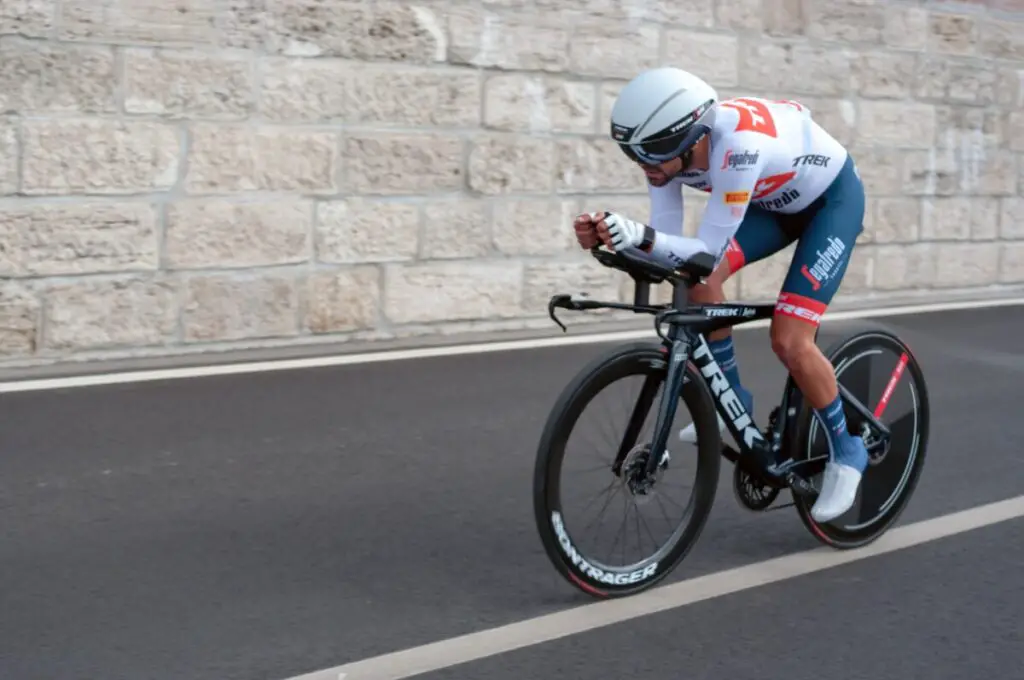When I started watching cycling, the prologue was one of the things I just didn’t understand at all. Over time, my curiosity got me researching what a prologue is, why it was introduced, and why we still need it.
A prologue is an individual time trial at the beginning of the stage race that must not exceed 8 kilometers (5 miles). It’s not regarded as a stage, but the rider’s times still count towards general classification. It’s primarily used to determine who wears the leader’s jersey on the first stage.
Now that we have a basic idea of what a prologue is, let’s dive a little deeper into the history, trends, and rules of that short but sweet part of cycling. Put your helmet on and let’s go!
What is a prologue?
International Cycling Union (UCI) has some rules regarding what is a prologue and what is not. But if the route meets all the restrictions, it is always the organizer’s decision whether to call the first day of racing a prologue or a normal first stage.
A prologue is not considered a stage. Whenever the race starts with it, the second day of racing is labeled as stage 1. Grand Tour (three-week race) therefore finishes with stage 20, even though riders did race for 21 days.
So let’s look at what defines a prologue.
- Distance. The prologue must be shorter than 8 kilometers (5 miles). Anything longer than that is considered a normal stage, though UCI turns a blind eye from time to time and allows prologue longer than that.
- Type of racing. The prologue must be an individual time trial, where riders start one by one. Normal mass start or team time trial cannot be a prologue.
From 2000 we witnessed sixteen prologues at three Grand Tours. They have become less common in recent years, but organizers still choose to have them from time to time.
| Race | Length | Winning time (in minutes) |
| 2000 Giro d’Italia | 4,6 km (2.8 mi) | 5:38 |
| 2000 La Vuelta a España | 13,3 km (8.3 mi)* | 17:08 |
| 2001 Giro d’Italia | 7,6 km (4.7 mi) | 7:44 |
| 2001 Tour de France | 8,2 km (5.1 mi)* | 9:20 |
| 2002 Giro d’Italia | 6,5 km (4.0 mi) | 8:12 |
| 2002 Tour de France | 7,0 km (4.3 mi) | 9:08 |
| 2003 Tour de France | 6,5 km (4.0 mi) | 7:26 |
| 2004 Giro d’Italia | 6,9 km (4.3 mi) | 8:30 |
| 2004 Tour de France | 6,1 km (3.7 mi) | 6:50 |
| 2005 Giro d’Italia | 1,15 km (0.7 mi) | 1:20 |
| 2006 Giro d’Italia | 6,2 km (3.8 mi) | 7:50 |
| 2006 Tour de France | 7,0 km (4.3 mi) | 8:17 |
| 2007 Tour de France | 8,0 km (5.0 mi) | 8:50 |
| 2009 La Vuelta a España | 4,8 km (3.0 mi) | 5:20 |
| 2010 Tour de France | 8,9 km (5.5 mi)* | 10:00 |
| 2012 Tour de France | 6,4 km (3.9 mi) | 7:13 |
| AVERAGE LENGTH | 6,8 km (4.2 mi) |
Why do we need a prologue?
You might wonder why would organizers even want a go through the effort of setting up the route, closing down the city streets and putting in all the effort, only for riders to be on the road for a few minutes. I don’t blame you, I was also wondering that before I did my research.
Once again, several reasons justify the inclusion of a prologue.
- Presenting riders to the public. Every rider starts alone, generally in a minute interval. Therefore, spectators can see all the riders alone for a few seconds and get an idea of who even competes in a race. Also, each rider gets a few minutes (or should I say seconds) of glory.
- Teams present new equipment. Teams often choose to present new equipment on Grand Tours. They are the biggest races with the most viewers, so the new equipment gets the most attention. A prologue offers a unique opportunity where new equipment is displayed alone, without the rival team’s bikes beside it, as is the case in normal stages.
- Riders safety. There are 184 riders at the start of the Grand Tour, each wanting to get a win and take the leader’s jersey. Having a mass finish with all riders competing for a win can be chaotic and dangerous. The prologue establishes some time gaps in the general classification and eliminates a few riders from contention for the leader’s jersey. So, fewer riders compete for it the next day, making the final kilometers much safer.
- Promotion. That’s probably the main reason we see prologues. As with all things, it comes down to money. Grand Tours often start outside the main country. Cities from all over Europe pay good money to host the opening days of the race. A prologue usually runs through the city’s streets, passing a few landmarks such as churches, palaces, museums, etc. Since every rider races alone, the landmarks are visible a lot, making an excellent promotion for the city.
The first stage of La Vuelta a España 2021 (which could be treated as a prologue, but the organizer decided against it) started inside a cathedral in honor of its 800th anniversary.
You don’t need to finish the prologue
The prologue differs greatly from the ordinary stage in terms of rules. The main difference between normal stages and prologue is that you don’t need to finish the prologue to keep racing the next day.
You are done with the race at every other stage if you don’t pass the finish line, but in a prologue, you can finish midway and still continue with the race. A rider that doesn’t come to the finish line is given the time of the slowest rider of the day.
Normally every rider finishes the prologue because the route is short and can be taken easily, as there is no time limit as is the case on “regular” stages. If you have a mechanical problem or you crash this rule can be quite helpful.
Do riders enjoy the prologue?

Different types of riders have a different attitudes to prologue – some love it, while some just want to get it done with.
I’ve asked Luka Mezgec, a sprinter of Australian team BikeExchange-Jayco, to tell me how he treats the prologue and how other riders see it.
“Riders for general classification treat it with a great amount of respect as their race can be ruined in a matter of seconds. Time trial specialists look at it with optimism as it represents their best chance on a race to get a win. As for others, it’s just fun. Short and technical, which makes it good for muscle activation before the real race begins.“
So, for the vast majority of riders, a prologue is just a few minutes of fun. At every prologue, a few riders need to go all out, but even if they have a bad day, the time lost is negligible, at worst a few seconds.
“Bernard Hinault and Francesco Moser are the most successful riders at Grand Tour prologues, both winning on 6 occasions.”
When was a prologue first introduced?
Cycling witnessed its first prologue back in 1967 when Tour de France organizers wanted to add something new to the race. The town of Angers will be forever written in history as the first city to host a prologue. Spectators could watch their heroes on 5.775 kilometers long route.
Spanish cyclist Jose Maria Errandonea won that day, beating local hero Raymond Poulidor by 6 seconds.
“The shortest prologue in history was 1 kilometer (0,6 mi) long. The winning time was 1 minute and 8 seconds.”
The introduction of a short race through the city turned out as a major success, so organizers decided to stick with it in the upcoming years. For the next 32 years, Tour de France started with a prologue until 2000, when it started again with a “normal” stage. This time 16,5 kilometers long individual time trial around Futuroscope amusement park in western France.
It didn’t take long for the other two Grand Tours to take a liking to the prologue. Giro d’Italia introduced it just a year later in 1968, and La Vuelta a España introduced it in 1970. Spanish race kept a prologue format until 1980, while the Italian race quickly started alternating between prologues and “normal” stages at the start of the race.
Will the prologue survive?
Nowadays, prologues are far less common than they were in the past. They are still included in a race from time to time, but the last time we saw one on a Grand Tour was back in 2012, when Tour de France started in Liege, Belgium.
In the future prologue will probably still be around, especially when a Grand Tour starts abroad. It presents a great promotional opportunity for big cities and if they are willing to pay, organizers are willing to include a prologue at the start of the race.

